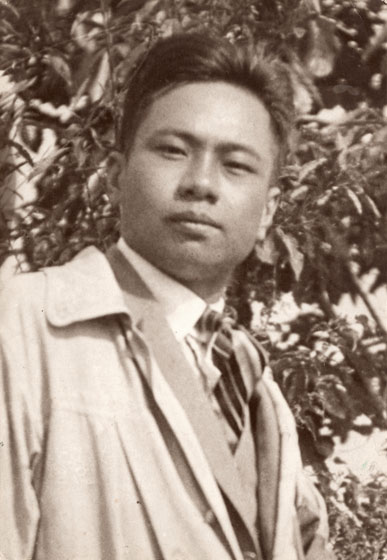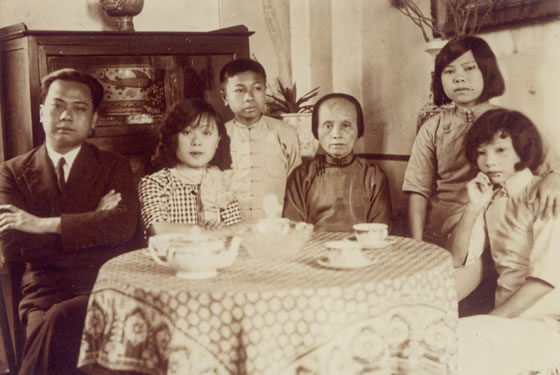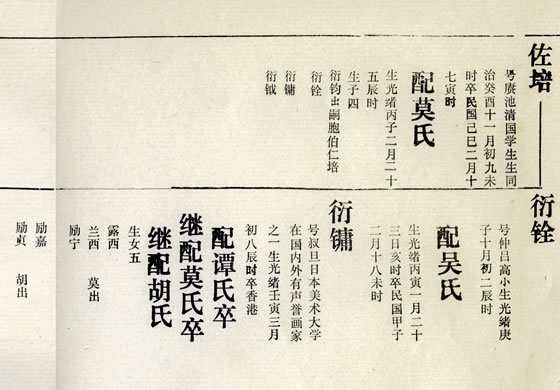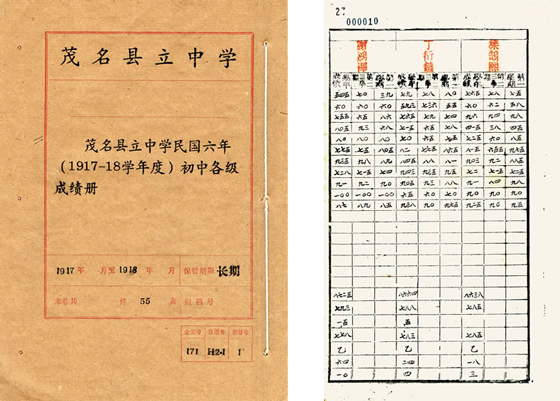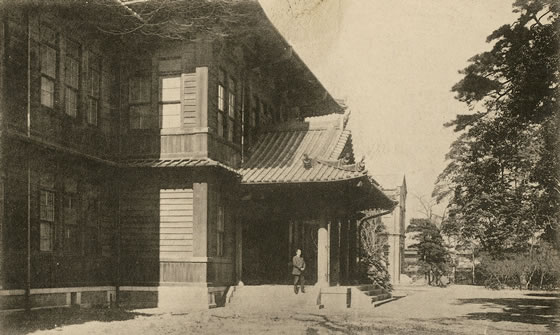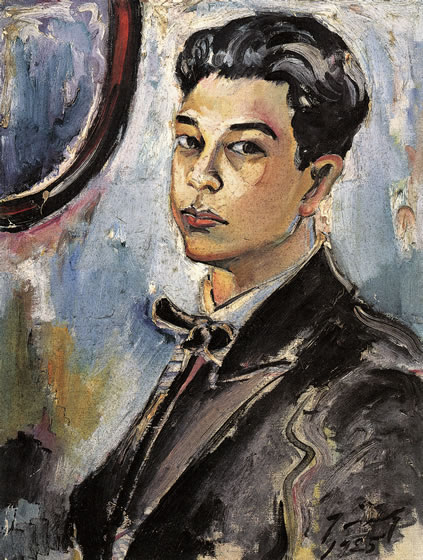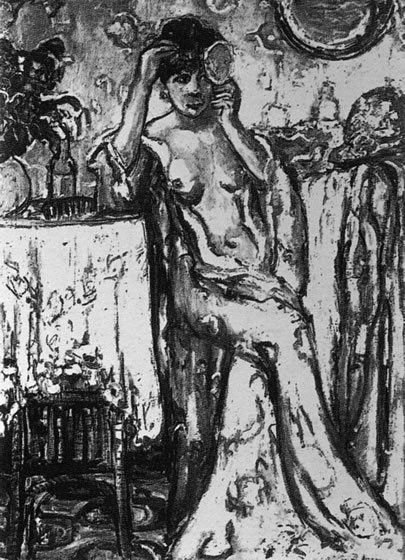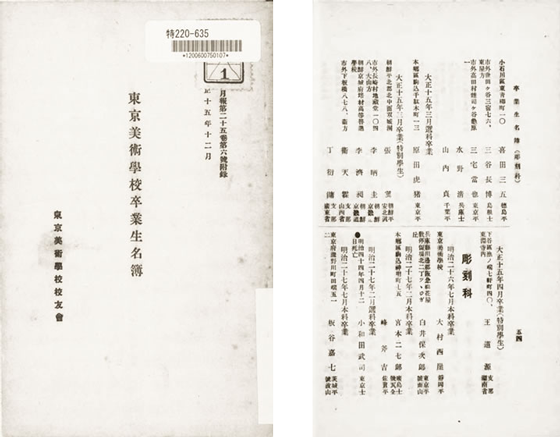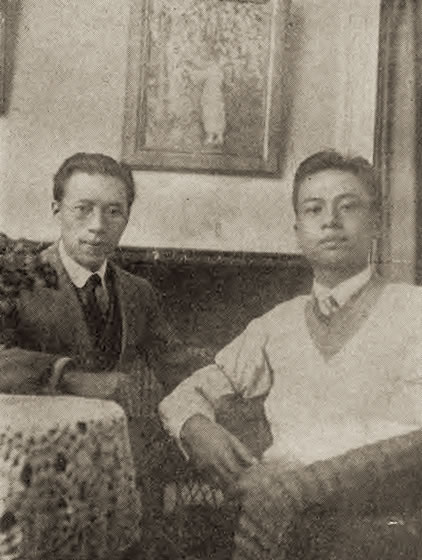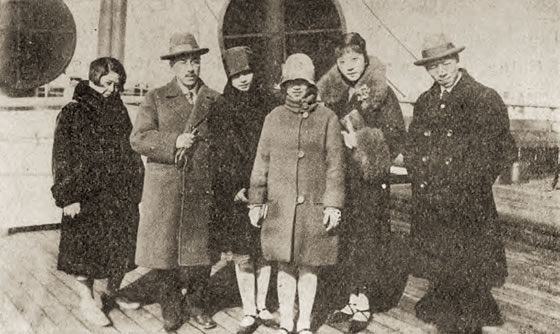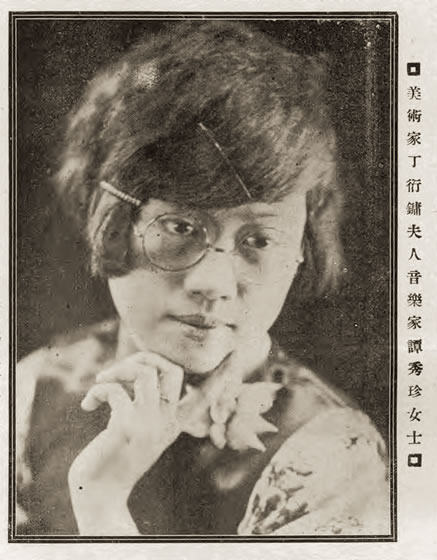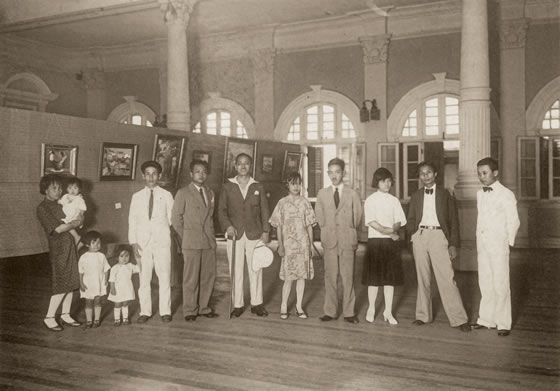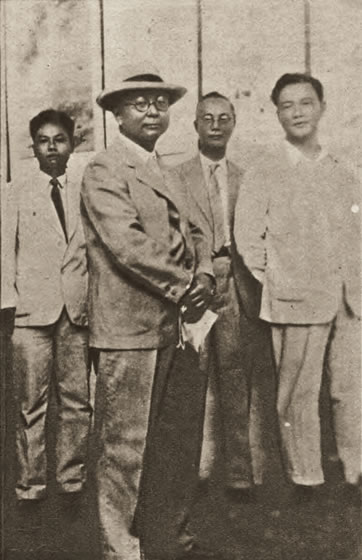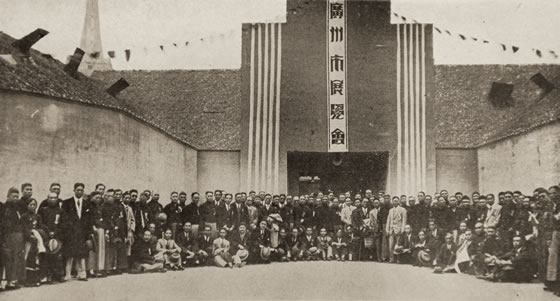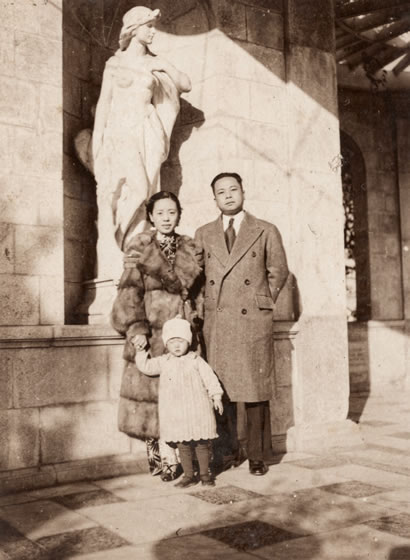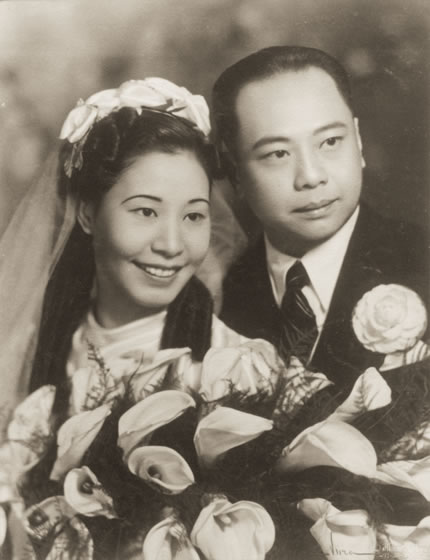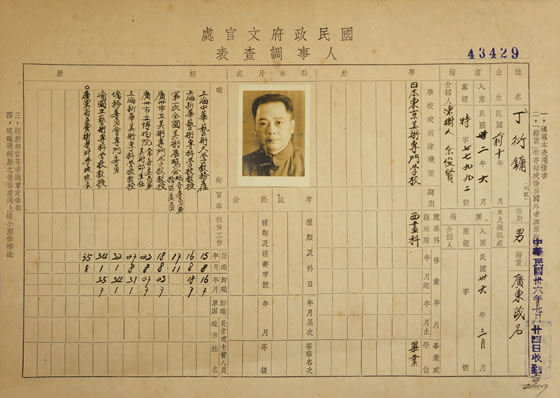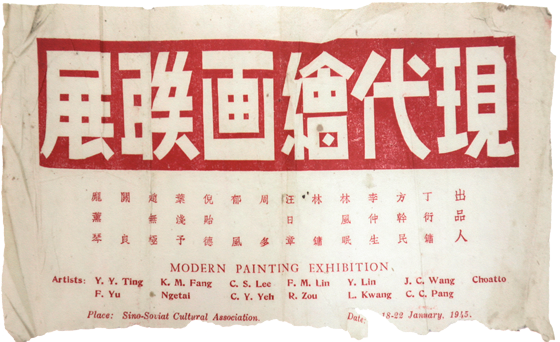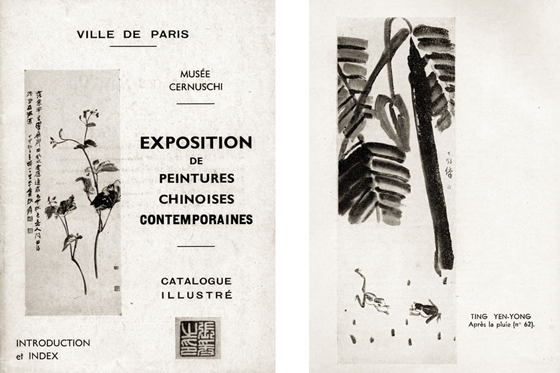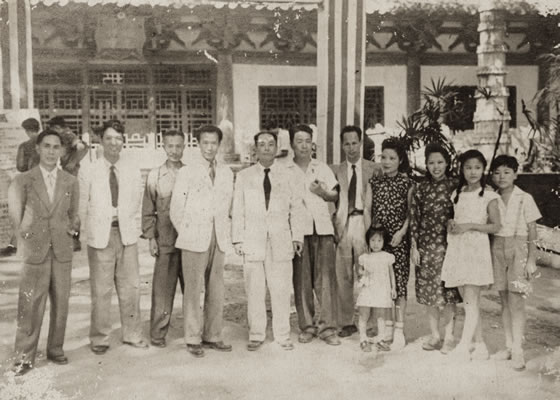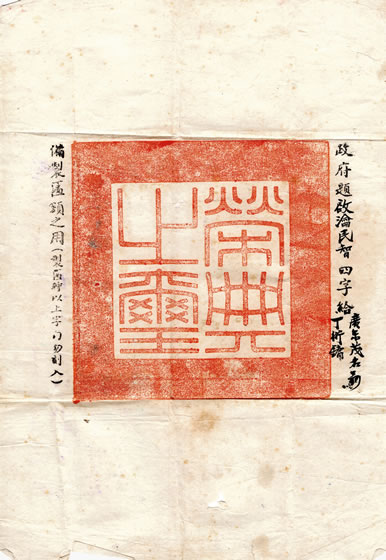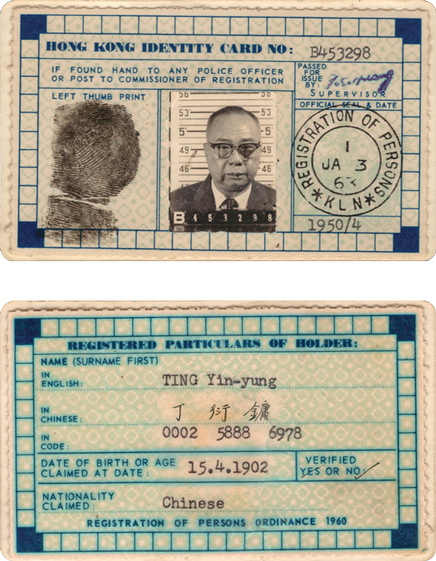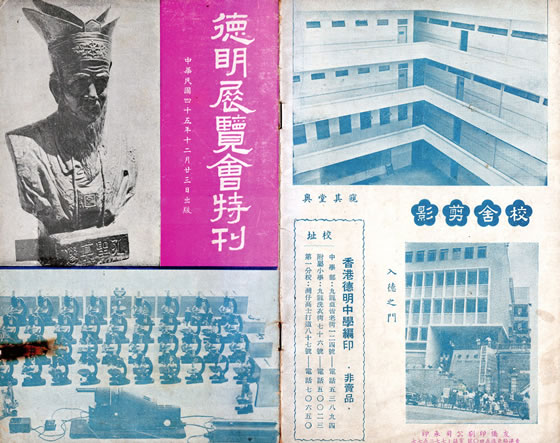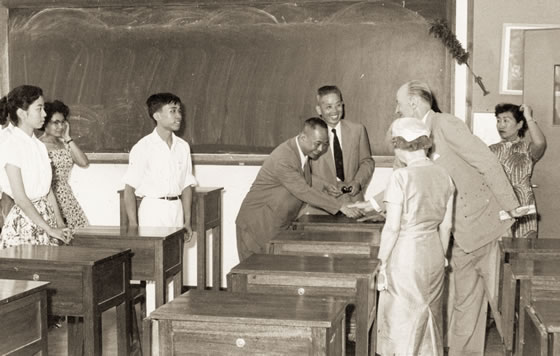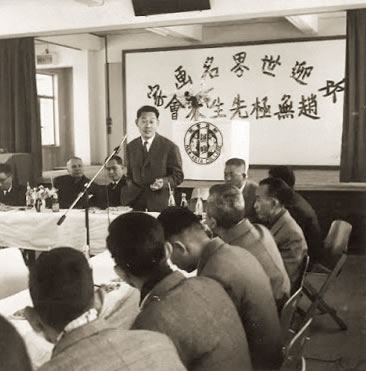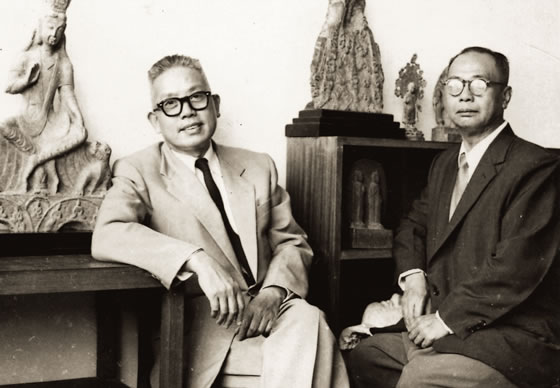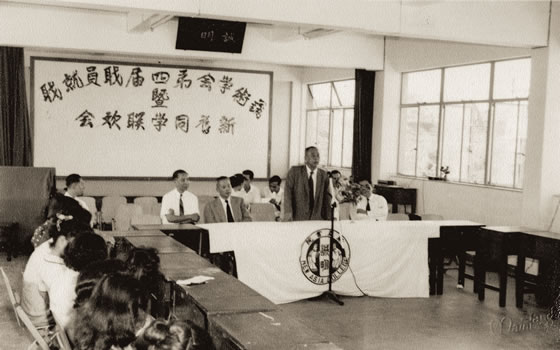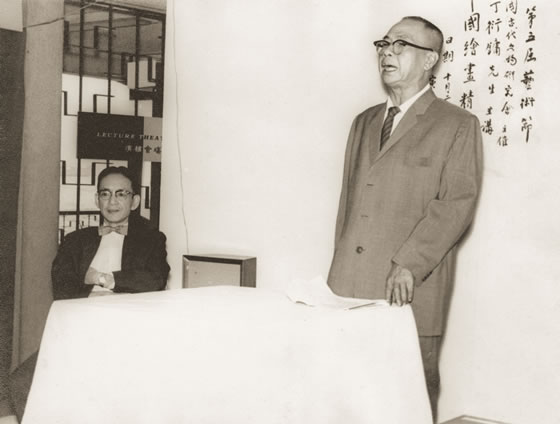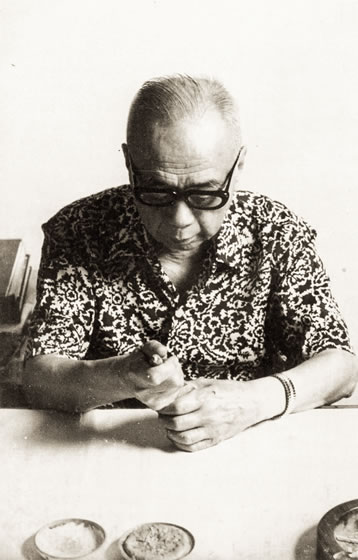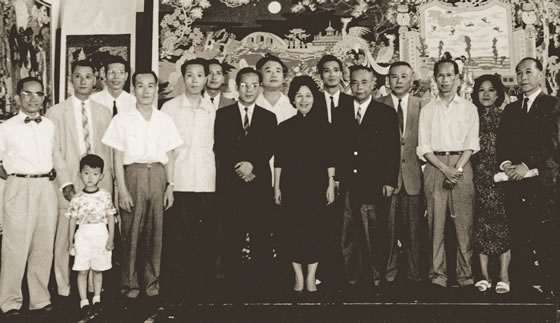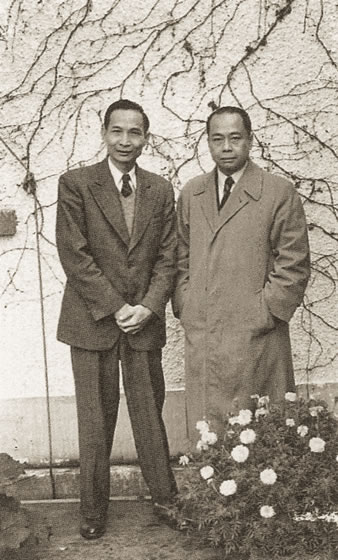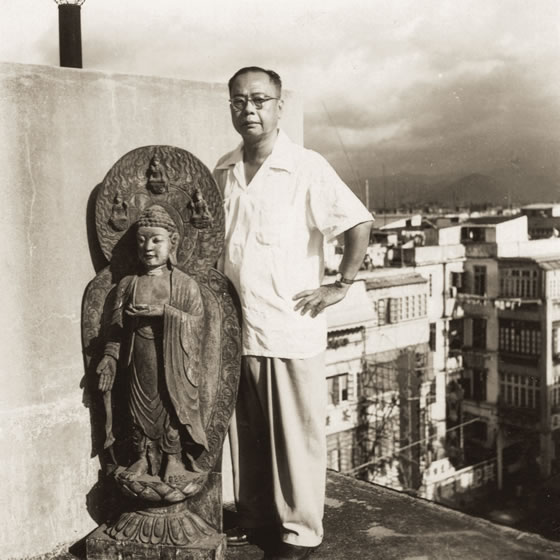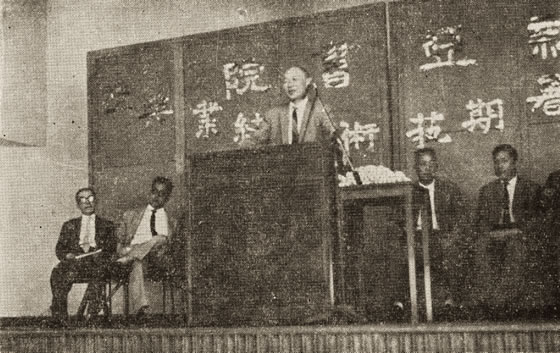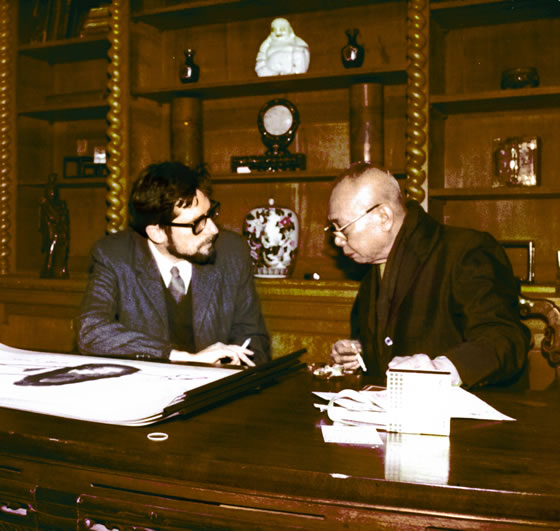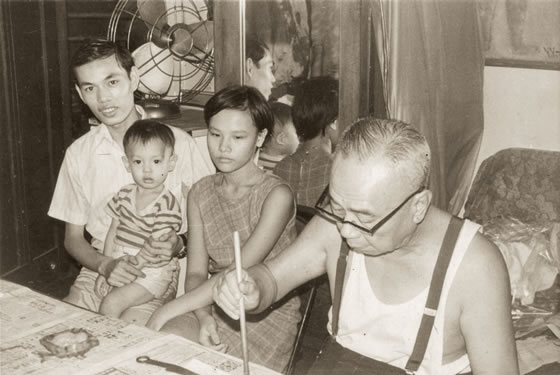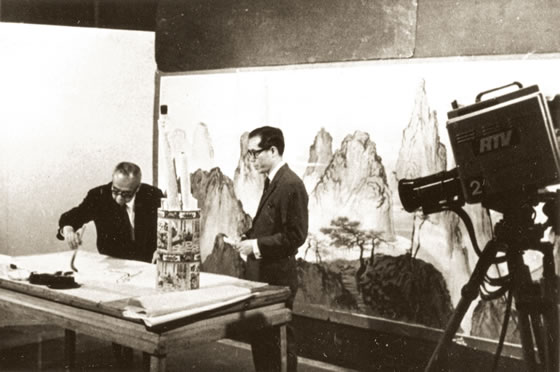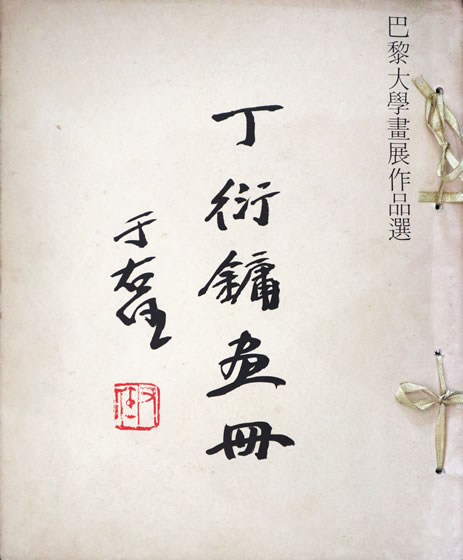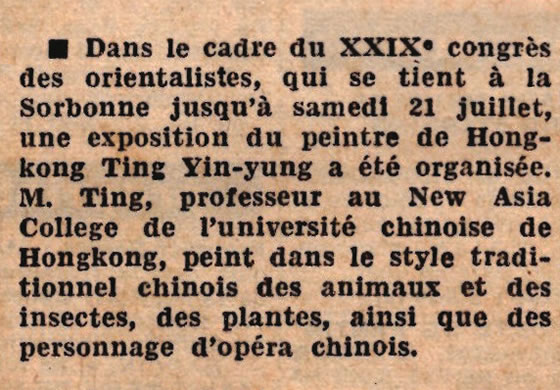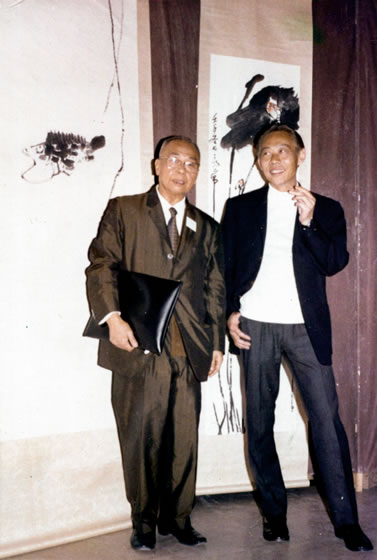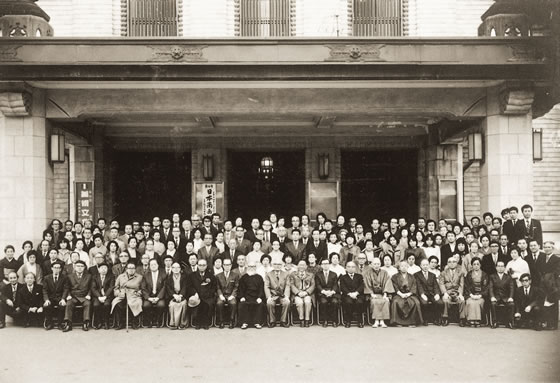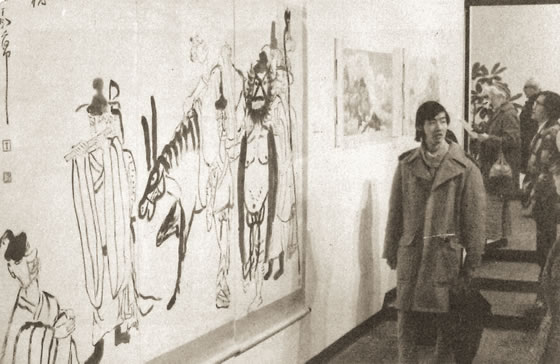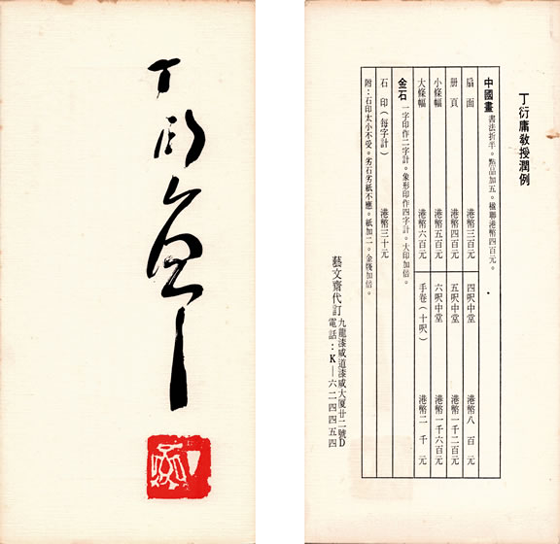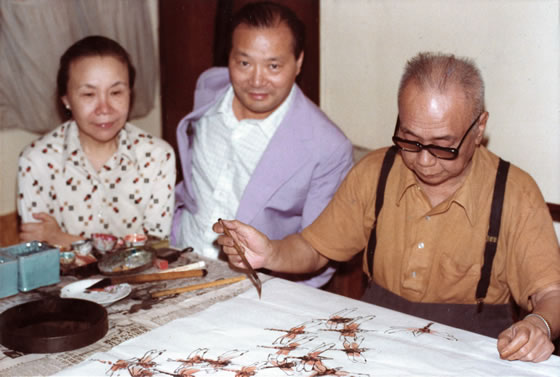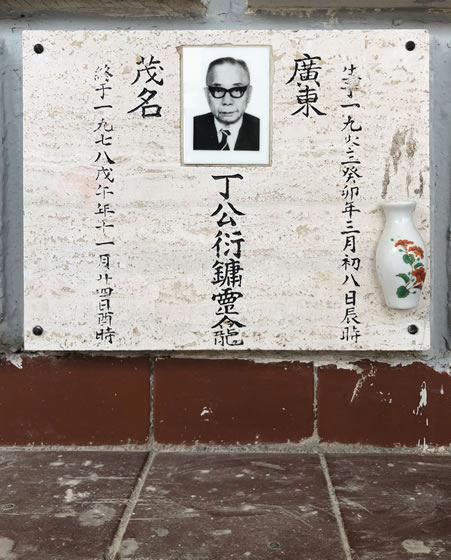Chronology
Ting Yin-Yung (Ding Yanyong) was born on 15 April (the 8th day of the 3rd month of the lunar year in the 28th year of the reign of Guangxu) in Maopo Village, Xieji Town (present-day Gaozhou), Maoming County, Guangdong Province. Yanyong was his given name, jibo his style name, and shudan his literary name.
—
Ting came from an affluent family. Showing talent in painting and calligraphy, Ting began his education at home with a private tutor. He later attended a primary school that was founded and funded by his father.
Ting began attending the four-year program at Maoming County Middle School (present-day Gaozhou Municipal Second Middle School).
After graduating from Maoming County Middle School, Ting went to Japan to study art. After his arrival in Tokyo in the fall, Ting studied Japanese before enrolling in the Kawabata Painting School.
In September, Ting enrolled in the Western-painting department of the Tokyo Fine Arts School as one of the six foreign students.
1922In May, Ting visited the first Exposition d’art français contemporain (Exhibition of French Contemporary Art), which featured Impressionist, Postimpressionist, and Fauvist paintings.
Ting was admitted to a course taught by Wada Eisaku in the oil-painting department.
—
Due to the calamitous Kanto earthquake of 1 September, there was a shortage of art supplies, and Ting lived in fear of another earthquake.
From 12 to 28 June, Ting’s still life On the Dining Table was exhibited at the Fifth Central Art Exhibition of Japan, organized by Chūō Bijutsu Zasshi (Central Arts Magazine) at the Bamboo Terrace Exhibition Hall at Ueno Park.
—
Returned home for the summer.
On 4 February, Ting attended a gathering of the Association of Chinese Overseas Students of the Republic of China at Kanda, Tokyo.
—
Ting completed his fourth-year coursework by the summer. As the fifth year was designated for completion of graduation paintings, students didn’t need to remain on campus. Therefore, when he had completed his graduation paintings—Self-Portrait and La Toilette—he returned home.
—
In the fall, Ting left Japan for Shanghai and accepted teaching posts in the art department of Lida Academy and the painting program of the Shenzhou School for Girls, as well as at the Shanghai University of Fine Arts.
—
In November, Ting wrote the preface for Zikai Cartoons, which was published in January of the following year.
—
Ting continued to paint despite his heavy commitments to art education. His style evolved away from the realist style learned in Japan toward more linear and modernist expressions in oil painting.
On 24 March, Ting graduated from the Tokyo Fine Arts School.
—
On 29 March, Ting met with Chen Baoyi and Xu Beihong at Chen’s studio, and appointed Xu to teach courses at Zhonghua University of Fine Arts later.
—
In April, Ting and Chen Baoyi organized a student trip to Hangzhou to practice life sketching and held an exhibition of the students’ sketches the following month.
—
In June, Ting and other faculty members participated in the first exhibition held at the Zhonghua University of Fine Arts.
—
Also in June, Ting was invited by the East Asian Art Alliance, founded by Qian Huafo and Huang Ching-wan earlier in the year, to attend a planning and selection committee meeting.
In August, by invitation, Ting spoke in the Chenguang Art Association summer lecture series.
—
In September, Ting, Chen Baoyi and Hong Ye founded the Chinese Art Association.
—
Also in September, Ting, Chen Baoyi, Chen Wang-tao, and Chen Zhifo established a graduate school at the Zhonghua University of Fine Arts.
—
In December, Ting, together with Chen Baoyi, Hong Ye and other instructors from the Zhonghua University of Fine Arts invited members of the Japanese Chunyang Club, Mr. Kotaro and Okada to participate in the Zhonghua University of Fine Arts exhibition.
In March, the Shanghai Art Alliance was formed. Ting, being one of the nine members in the operating committee, was appointed with Chen Wang-tao to establish and maintain good relations with the Shanghai Kuomintang Party.
—
In April, Ting was appointed section chief of the art division of the National Revolutionary Army of the Shanghai Special Municipal Government.
—
From 2 to 5 June, Ting held a solo exhibition of oil paintings of figures, landscapes, and still lifes, as well as drawings and works in pastel. This was Ting’s first solo exhibition since his return from Japan. According to the newspapers, this exhibition was originally scheduled for 24–27 March but was postponed until June because of the turmoil in Shanghai resulting from the Northern Expedition.
Records indicate that Ting held teaching posts at Xinhua from August 1927 to July 1929 and again from August 1938 to January 1942.
—
In June, Ting showed oil paintings in the Zhonghua University of Fine Arts Exhibition.
—
In July, Ting published the article “Opinions on the Urgent Establishment of the Art Department at the Fourth Zhongshan University” in Shun Pao.
—
In August, the Zhonghua University of Fine Arts proposed a joint exhibition, which was held in the next month. Ting, in addition to showing three works, published an essay, “The Meaning and Expectations of the Joint Exhibition.” This was the first public exhibition to bring together all different painting styles in Shanghai.
On 20 February, Ting attended a dinner for Arishima Ikuma, of the Nika Association of Japan, that was hosted by Chen Baoyi.
—
In June, together with Chen Baoyi, Zhang Shuguang, Zhu Yingpeng, Liang Te-so, Yu Jifan, Chen Hong, as well as faculty and members of several art institutions and associations, launched the Shanghai Art Alliance, who held their first exhibition in Shanghai in October. In addition to serving as a member of both the planning committee and the review committee and as director of the receiving office for the Zhonghua University of Fine Arts, Ting exhibited four oil paintings.
—
In August, Ting, Guan Liang, Chen Zhifo, and Tan Huamu organized the Shanghai Arts Club.
In the fall, Ting returned to Guangzhou. At the end of the year, Lu Yao-kang, director of the Guangzhou Municipal Education Bureau, appointed Ting to the standing and planning committees for the Guangzhou Municipal Museum (now the Guangzhou Museum), which were responsible for drafting the organizational plans. After taking office, Ting went to Shanghai from mid-December to the end of January of the next year to implement the collection plan.
—
Ting joined the Guangzhou Municipal Art School as professor of Western painting.
In January, during his visit to Shanghai to collect works for the Guangzhou Municipal Museum, Ting was invited to serve as a member of the adjudicatory and selection committees for the First National Art Exhibition of the Republic of China. Ting exhibited the oil painting Girl Reading in the exhibition, which was held in Shanghai from 10 to 30 April 1929.
—
The 3 January issue of Pictorial Shanghai featured a photograph with the caption “Artist Ting Yin Yung’s musician wife Tan Xiuzhen.” The Maodong Ting Family Genealogy confirms that Tan Xiuzhen was Ting’s first wife, but the exact date of their marriage is unknown.
On 11 February, the Guangzhou Municipal Museum opened in the town of Yuexiushan. After the opening, Ting continued to serve as a member of the standing committee and director of the art department, posts he kept for nearly ten years. During his tenure, he had the chance to learn about Chinese traditional painting and antiquities; since his training was primarily in modern Western-style art, this opened new doors for him. After years of study, he bought his first painting by Bada Shanren in 1936.
—
On 19 February, Ting, Kao Chien-fu, Chen Zhifo, and other artists founded the Guangzhou Art Research Association.
—
Ting’s father passed away on 27 March.
At the beginning of the year, dissatisfied with the administration of the Guangzhou Municipal Art School, Ting, Chen Hong, and Chen Zhifo convened a general meeting of faculty and students.
—
In May, Chinese and Japanese painters, including Ting, Chen Hong, and Koboyashi Morimoto held the Sino-Japanese Joint Painting Exhibition in Guangzhou.
In June, published the article “A Revolution Cannot Disregard Art and Art Cannot Disregard the Revolutionary Chen Shu-jen.”
—
In July, Chen Shu-jen held a solo exhibition in Guangzhou for which Ting wrote a review.
—
In December, Ting donated paintings to an exhibition to benefit relief victims organized by He Xiangning in Shanghai.
On 15 July, Chen Shu-jen’s solo exhibition opened in Shanghai. Chen asked Wang Chi-yuan and Ting to preside over the exhibition. Ting wrote two articles about Chen, “Chen Shu-jen’s Art and What It Represents” and “A Brief Biography of Chen Shu-jen.”
—
In the same month, Ting attended the tenth graduation and the faculty-and-student exhibition of the Shanghai College of Fine Arts.
—
This year Ting was listed as instructor in the Guangdong College of Sports Graduating Students Book.
—
Ting published his memoirs, “A Personal Account.”
From 15 February to 16 March, Ting showed an oil painting, City, in the First Guangzhou Municipal Exhibition.
1934In May, in an exhibition of works by the nine members of art-promotion committee of Guangzhou Provincial Public Education Center, Ting showed ink sketches, oil paintings, and pastels.
—
On 20 July, Ting’s wife, Mo Suwen, gave birth to their first child, daughter Lo Sai. According to Ting’s student Mok E-den, Ting and Suwen met through Chen Chi-tang’s wife, Mo Shuying, who was Suwen’s aunt and also from Maoming. Their wedding date is unknown.
In March, Ting participated in the first exhibition held by the Chinese Independent Art Association.
—
On 5 June, Ting published the article “Kao Chien-fu: Unifying Chinese and Western Art” in the Central Daily News.
—
In December, Ni Yide published “My Friends in the Art World: Four, Reminiscences” in Youth World. In it he describes his relationship with Ting, Chen Hong, and Chen Zhifo.
On 1 June, Ting’s second daughter, Lan Sai, was born in Shanghai.
—
Ting had a painting studio in the French Concession in Shanghai.
In March, Ting’s third daughter, Siu Sai, was born.
—
In May, Ting’s wife, Suwen, passed away.
—
On 2 December Ting married Hu Saibi, whom he met at the Guangdong College of Sports, at the Shanghai New Hotel.
The monthly magazine Art World asked artists to contribute diary entries for their series “A Day in the Art World.” Ting submitted his diary entry for 24 February.
—
On 26 July, Ting’s fourth daughter, Lai Ning, was born in Shanghai.
—
In November, together with Zao Wouki, Yan Wenliang, Wang Ya-chen, Chow Pechou, Tsu Chi-Jen, and others, Ting participated in the exhibition entitled “A Joint Exhibition of Western-Style Artists in Shanghai.”
In June, Ting participated in the Modern Painting Exhibition in Shanghai.
—
During the summer, Ting and Ni Yide started a summer painting workshop.
Shortly after the onset of World War II, Ting left Shanghai to escort his family to his hometown, Maoming, before heading to Chongqing, the wartime capital.
In January, Ting served on the Overseas Chinese Affairs Commission, serving as aide to Chen Shu-jen until January 1945.
—
In June, Ting joined the Kuomingtang through the introduction of Chen Shu-jen and Yu Junxian. His party card number was 77992.
—
In the same month, Ting, Chen Shu-jen, Guan Liang, Zou Haibin, and Li Ping held a painting exhibition at Sichuan Arts Association in Chengdu.
In August, Ting exhibited two ink paintings in the Ying Society Poetry, Calligraphy, and Painting Exhibition, held by the Sino-Soviet Cultural Association in Chongqing. According to extant archival material, this was the first time Ting exhibited ink paintings.
In January, Ting started to teach at the National Art School in Chongqing; he would remain in that post until July of the following year.
—
From 18 to 22 January, Ting participated in a Modern Painting Exhibition at the Sino-Soviet Cultural Association together with Lin Fengmian, Guan Liang, Fang Ganmin, Li Chun-Shan, Yu Fung, Ni Yide, Pang Hiunkin (Pang Xunqin), Zao Wouki, Lin Yong, Wang Rizhang, Zhou Duo, and others.
—
In March, Ting and Guan Liang were responsible for planning the thirty-fourth exhibition of the National Art School. In the same month, students from Guangdong organized a tea party to welcome Ting.
From 1 to 5 June, Ting, Lin Fengmian, Guan Liang, Chu Teh-Chun, J. C. Wang, Li Keran, Li Chun-Shan, Toupin, Hu Shanyu, Ni Yide, Xu Taigu, Weng Yuanchun, Zao Wouki, and others participated in the First Independent Art Exhibition at Chongqing’s Central Library.
—
During his tenure at the National Art School, Ting shared an apartment with Guan Liang and Lin Fengmian, with whom he developed deep and lasting friendships.
After the Sino-Japanese War ended, Ting returned to Shanghai, where he became a member of the Nine-Person Painting Group along with Tsu Chi-Jen, Guan Liang, Ni Yide, Chen Shih Wen, Chow Pechou, Tan Yun, Qian Ding, and Soong Tsoong Yuen.
—
In June, Ting exhibited five ink paintings in the Exposition de peintures chinoises contemporaines at the Cernuschi Museum in Paris. One of the five, Après la pluie, was acquired by the museum.
—
In August, Ting traveled to Guangzhou from Shanghai to take up his appointment as principal of the Guangdong Provincial College of Art, a post he held until 1949.
—
In November, Ting attended the Painting Charity Exhibition organized by members of the Guangzhou art world to raise funds for the Sun Yat-sen Library.
On 7 January, Ting was invited by the principal of the South China Art School, Kao Chien-fu, to give a talk on new trends in the international art world.
—
From 25 to 30 March, participated in a Joint Art Exhibition held by the Guangdong Provincial College of Art and the South China Art School.
—
In June, Ting wrote the article “Chen Shu-jen and His Art” for an exhibition held in Guangzhou.
—
In July, Ting showed the ink painting Lotus in the Disaster Relief Exhibition.
—
In August, Ting wrote an article entitled “Written before Dabu’s Exhibition” on the occasion of an exhibition by Liu Dabu at the Sun Yat-sen Library.
In October, Ting invited journalists to the fifth anniversary celebration of the Guangdong Provincial College of Art.
—
On 3 November, Ting took seventy students to Foshan for life sketching together with Yang Qiuren, Pang Hiunkin, and Tan Huamu.
At the beginning of January, the municipal government gave Ting and Kao Chien-fu the task of planning an exhibition to raise funds for the Sun Yat-sen Library.
—
In January, the Guangdong Provincial College of Art held a faculty-and-student exhibition in which Ting, Pang Hiunkin, Yang Qiuren, and Tan Huamu took part.
—
On 10 February, Ting’s fifth daughter, Lai Kar, was born in Guangzhou.
—
In February, Ting participated in an exhibition promoting peace and restoration held by the Guangzhou Municipal Culture Promotion Committee.
—
To commend Ting’s contribution to the Guangdong Provincial College of Art, the Nationalist government issued to Ting a special-commendation plaque for “elevating the people’s knowledge.”
On 1 June, Ting and the faculty of Guangdong Provincial College of Art attended the opening of an exhibition curated by Kao Chien-fu at the Guangzhou Municipal Art College.
—
On 19 June, Ting spoke at the awards ceremony of the Guangdong Provincial Elementary and Secondary School Mandarin Drama Competition.
—
On 28 September, Ting wrote “Birthday Wishes to Mr. Kao Chien-fu” on the occasion of Kao’s seventieth birthday.
—
On 1 December, Ting delivered a speech for the first-anniversary celebration of the Guangzhou Municipal Art College.
—
In December, Ting was invited to participate in the exhibition “Important Paintings by Lingnan Masters” at the City Hall in Taipei.
From 23 to 26 February, Ting and Kao Chien-fu organized a posthumous exhibition for Chen Shu-jen at St. John’s Cathedral.
—
On 25 March, at the Art Festival Gala, at the Sun Yat-sen Library, Ting delivered a speech entitled “Celebrating the Meaning of the Art Festival.”
—
On 5 May, to celebrate Literature and Art Day, Ting wrote “The May Fourth Movement Is the Beginning of the Eastern Art Renaissance”.
—
On 1 October in Beijing, the Chinese Communist Party announced the official establishment of the People’s Republic of China. Ting arranged for his wife and daughters to take his paintings and some of his collection home to Maoming. He then traveled alone to Hong Kong on 13 October, taking with him only a few of his paintings by Bada Shanren and Shitao, as well as his collection of ancient seals.
—
On 23 October, Ting’s sixth daughter, Lai Ching, was born in Maoming.
In April, the Hong Kong government issued an identity card to Ting.
—
Despite being destitute, Ting continued to send money and other necessities to his family in Maoming. However, to protect his family, Ting used a pseudonym, Ding Jianjun, or his wife’s cousin name, Hu Saijian, to send things home.
—
Bumped into his former student at the Guangdong Provincial College of Art, Wu Ziyu, and went living at Castle Peak together for a while.
—
In December, Ting received word from the Kuomingtang Central Committee in Taipei in response to his registration application that he had been re-registered as a member of the Hong Kong chapter of the Kuomingtang, membership number 2349.
In July, Ting completed an application with the Ministry of Education of the Republic of China to be a reserve professor.
—
In August, the Ministry of Education of the Republic of China confirmed receipt of Ting’s application and reissued his lost professor’s certificate.
—
Ting started to teach art courses at the Tak Ming Middle School on 1 August, and he moved from his living quarters at Castle Peak to the school’s dormitory.
—
In addition to teaching at the Tak Ming Middle School, Ting also taught at Chu Hai College and Houng Kong College from 1954 to 1959 and from 1963 to 1967 respectively.
Ting’s mother, wife, and third daughter all passed away during this year, causing him immeasurable sadness. During this desolate period of his life, his collection of Bada Shanren, Niu Shihui, Xu Tianchi, Shi Tao, and Shi Xi paintings became his companions and teachers.
Judging by extant paintings, this year marked Ting’s first uses of archaic script in his oil paintings.
—
The evening of 17 May, Ting attended a yaji, or literary gathering, of the Hong Kong art world to welcome the dean of the art department of Taiwan Normal University, Huang Chun-Pi, who was visiting Hong Kong.
On 5 May, at the invitation of the art division of the Hong Kong Teachers’ Association, Ting gave a lecture, “Modern Art and Education,” at the Sixth Teaching Seminar. The following year, Ting published “Views on Teaching New Art,” which emphasizes the need to understand children’s paintings and primitive art, laying the foundation for his own method of teaching modern art.
—
In November, Ting was invited by the Hong Kong Chinese Art Club to be a member of the vetting committee for the Hong Kong Chinese Painting Exhibition Southeast Asian Tour, to which he contributed an ink painting.
—
In December, an art exhibition was held to commemorate the opening of the new school building at Tak Ming Middle School. A special publication on the exhibition included an article by Ting entitled “On Art.”
In January, Ting participated in an exhibition entitled Appreciation of Chinese Painting and Calligraphy jointly organized by New Asia College and Chu Hai College.
—
On 5 January, Ting gave a talk at the Mencius Library entitled “Chinese Painting and the Development of Western Painting.”
—
In late January, Ting showed an ink painting in the Book and Magazine Exhibition organized by the Hong Kong Publishers’ Association.
—
In February, the Fine Arts Specialized Training Program was established at New Asia College. As an adjunct professor, Ting taught courses in watercolor painting, oil painting, and traditional Chinese painting, as well as a teaching in the summer arts program.
—
In March, Ting showed an ink painting of a lotus in the Third Free China Art Exhibition, held at the Shin Sheng Daily News Building in Taipei.
—
Also in March, Ting, Lui Shou Kwan, Chao Shao-an, Young Sin Sum, Lee Yin Shan, Lee Shak-Pang, and Wong Po-yeh participated in the exhibition Recent Works by the Society of Seven Hong Kong Artists.
On 31 March, Ting attended a traditional yaji at the Chi Lin Nunnery on Diamond Hill.
—
In April, together with Qi Baishi, Pan Yulin, and Chou Lin, Ting took part in the Animal Painting Exhibition organized by the National Museum of History, Paris.
—
From 23 to 27 April, the British Council of Hong Kong hosted the Exhibition of Recent Oil Paintings by Y. Y. Ting, in which Ting exhibited twelve oil paintings. This was Ting’s first solo exhibition since arriving in Hong Kong.
—
On 18 May, at the invitation of the Chinese division of the Hong Kong Teachers’ Association, Ting gave the keynote address at the association’s Seventh Teaching Research Conference.
—
In early June, Ting, together with Chen Shih Wen and C. C. Wang, organized the Exhibition of Ancient Masterpieces at New Asia College Library.
—
Also in June, Ting wrote an article “On Lin and Zhao’s Painting Exhibition.”
In July, Ting participated in the first faculty-and-student exhibition organized by New Asia College’s Fine Arts Specialized Training Program.
—
From 28 September to 6 October, Ting participated in the Fourth National Art Exhibition of the Republic of China.
—
At the end of October, Ting participated in the Exhibition of Recent Works by the Guangzhou Municipal Art School’s Hong Kong Alumni at St. John’s Cathedral Old Hall in Hong Kong.
—
In November, Ting and other Hong Kong painters, including Szeto Kei, Lee Yin Shan, Pao Shiu-Yau, Chao Shao-an, and Lui Shou Kwan, donated paintings for an exhibition held to raise funds for the expansion of Lingnan Middle School in Hong Kong.
—
In December, New Asia College hosted An Exhibition of Ancient Chinese Seals and Carvings, comprising Ting’s personal collection. The exhibition included Buddhist statues from the Northern Wei, Western Wei, Northern Qi, and Sui and Tang dynasties and seals from the Shang and Qin dynasties.
In January, Ting published “Looking at Ancient Seals from the Perspective of Traditional Chinese Culture.”
—
Also in January, Ting was awarded the Alumni Association Certificate by the Taipei Overseas Chinese Correspondence School.
—
On 16 January, Ting loaned his collection to New Asia College’s Exhibition of Chinese and Western Paintings and gave gallery talks.
—
In February, Ting and Chen Shih Wen invited Zao Wouki to give lectures at the Fine Arts Specialized Training Program of New Asia College and to teach Western painting. With Ting and Chen’s encourgement, Zao exhibited nine small-scale paintings from his oracle-bone series. The exhibition in fact had a profound impact on the Hong Kong art scene and inspired the development of modern art in Hong Kong.
In May, Ting donated an ink painting, Morning Glory, to the first Wah Kiu Yat Po Save the Children charity auction.
—
From 28 June to 2 July, Ting showed both ink and oil paintings in the Fourth Free China Art Exhibition, held at the Shin Sheng Daily News Building in Taipei.
—
In July, Ting participated in the exhibition of New Asia College’s Fine Arts Specialized Training Program and served on the planning and vetting committee.
—
Also in July, Ting served on the planning committee for the Chinese Ancient Art Exhibition.
In September, Ting served as chairman of the secondary-school division of the Arts Teaching Research Conference hosted by the art division of the Hong Kong Department of Education.
—
On 4 October, Ting attended the fourth inaugural ceremony for the Student Association of the Fine Arts Specialized Training Program of New Asia College.
—
On 18 October, Ting took students from the Fine Arts Specialized Training Program to the outskirts of Tai Po to sketch.
—
On 29 November, Ting gave a lecture titled “Bronze Inscriptions and Calligraphy” at New Asia College.
—
According to available material, Ting taught at the All Saints’ Middle School from 1958 to 1964.
In February, the Art Department of New Asia College, with a four-year program, was officially established. Ting served as an adjunct professor in the newly established department until 1978.
—
In April, He Tiehua, a participant in the emerging new art movement in Taiwan, and his daughter, He Guchuan, traveled to Hong Kong from Taiwan for a joint exhibition. Ting wrote an article on their exhibition entitled “Impressions of the Father and Daughter Exhibition.”
—
At the end of April, participated in the Free China Art Exhibition in Hong Kong and Kowloon.
—
From 31 April to 2 May, Pan Qiaofeng held her first exhibition in Hong Kong, for which Ting wrote “Impressions of the Pan Qiaofeng Exhibition.”
—
In May, Ting showed the ink painting Songshi Youhui (Pine Tree and Rock) in the exhibition Chinese Masterpieces, organized by the Chinese Fine Arts Association.
From 6 to 21 May, Ting participated in an exhibition of paintings by students and faculty of the Department of Fine Arts, New Asia College, at the Yale University Art Gallery under the auspices of the Yale-in-China Association.
—
On 9 May, Ting attended the Ninth Teaching Research Conference, organized by the Chinese division of the Hong Kong Teachers’ Association.
—
In August, Ting showed oil and ink paintings in the faculty-and-student exhibition of New Asia College.
—
On 22 October, Ting attended the Fifth Hong Kong Arts Festival and gave a speech entitled “On the Spirit of Chinese Painting.”
In the early 1960s, after years of collecting and studying ancient seals, Ting started carving seals himself.
—
In January, Ting showed the ink painting Songshi Youhui in an exhibition organized by the China Fine Arts Association to benefit children in need.
—
In February, Ting donated an ink painting, Bajiao, to the third Wah Kiu Yat Po Save the Children charity auction.
—
In May, Ting was appointed a member of the art section of the Chinese division of the Hong Kong Teachers’ Association.
—
On 22 August, Ma Paisui, a professor in the art department of Taiwan Normal University, traveled to Hong Kong for a holiday of more than a month. After he visited the Department of Fine Arts at New Asia College and meeting with Ting, the two artists exchanged paintings.
—
On 25 September, Ting was appointed honorary advisers to the Hong Kong Chinese Art Club.
In March, Ting donated a painting to the fourth Wah Kiu Yat Po Save the Children charity auction.
—
In the same month, Ting showed ink paintings Willow Tree and Lotus in an exhibition held by the Hong Kong branch of the World University Service Association.
—
In May, Pan Qiaofeng had a second exhibition, for which Ting wrote “Discussing Pan Qiaofeng’s Exhibition from the Perspective of Women Artists.”
—
In June, Ting wrote “Bada Shanren and Modern Art.”
—
In August, Ting, upon viewing the August Salon exhibition of works by graduates of the Taiwan Provincial Normal University in Hong Kong, wrote “August Salon Tour: Written for the Graduation Exhibition of the Taiwan Normal University.”
In September, Ting was appointed dean of the art department of Tak Ming College, serving until the school closed two years later.
—
In the same month, Ting loaned his own collection to Tak Ming College for a teaching exhibition and wrote “On the Spirit of China’s Cultural Tradition and Artistic Creation: Teaching Exhibition for Tak Ming College.”
—
On 28 September, Ting showed the ink painting Fish and Shrimp in the Twelfth Anniversary Art Exhibition at New Asia College.
—
In November, Ting published “Xu Tianchi and Modern Art.”
—
In the same month, as Szeto Kei’s mentor, Ting wrote “From the Spirit of Guangdong: Szeto Kei’s Testimony” for Szeto’s solo exhibition.
—
Also in November, Ting delivered a lecture at the Far Eastern Academy entitled “Art and Life.”
—
Ting published “The Path of Art.”
In July, Ting showed oil paintings in New Asia College’s annual faculty-and-student exhibition.
—
Also in July, Ting wrote “The Art and Personality of Shi Xi.”
—
In August, Ting wrote “Preface to Paintings by Liang Weili.” Liang was a student at New Asia College.
—
Also in August, Ting organized the first exhibition of the art department of Tak Ming College.
—
In September, Ting attended an exhibition of works by Lau Ping-hang, an instructor at Tak Ming College, about which he wrote “On the Third Exhibition of Professor Lau Ping-hang.”
—
In November, Ting participated in the Exhibition of Old and New Masterpieces and Archaeological Relics at the Oriental Art Museum of Hong Kong. He gave a demonstration of painting on site.
Ting started to sign his oil paintings “Y. Y. Ting” instead of “Y. Ting.”
—
According to available information, Ting taught at Da Tong College from April 1963 to January 1964.
—
On 28 July, Ting attended and spoke at the opening ceremony for the Hong Kong Alumni Association of Guangzhou Municipal Art School.
—
In August, Ting spoke at end-of-term ceremony for the summer arts program.
—
In September, after the closing of the art department at Tak Ming College, Hung Tao College of Art was founded, with Ting as dean.
—
In October, the Chinese University of Hong Kong, uniting New Asia College, Chung Chi College, and United College, was established. Ting remained a part-time instructor.
—
Also in October, at the invitation of the Tsuen Wan Princess Alexandra Community Centre, Ting organized an exhibition of oil and ink paintings. At the event, Ting gave a spontaneous demonstration of painting.
From the end of November to the beginning of December, with the support of New Asia College’s President Ch’ien Mu, Vice President Wu Junsheng, Dean of the College of Literature Tang Chun-i, and the board of Hung Tao College of Art, Ting mounted an exhibition of his recent works at the Chinese Cultural Association. The well-known Belgian sinologist and essayist Pierre Ryckmans wrote an essay before the exhibition.
—
Ting published the article “Copying and Creation.”
In January, Ting hosted the art symposium of Fu Feng Fine Art School.
—
In February, Ting showed ink and oil paintings in New Asia College’s faculty-and-student exhibition.
—
In September, Ting became director of the art department of Tsung Hwa College, where he also taught Western painting.
In February, Ting showed ink and oil paintings in a faculty-and-student exhibition at New Asia College.
—
In November, Ting participated in an appreciation of painting at Elsa Art House, and he was invited to host the ribbon-cutting ceremony for the gallery’s annex.
—
In December, Ting attended the second inaugural ceremony of the Hong Kong Alumni Association of Guangzhou Municipal Art School and gave a speech.
—
Ting wrote the preface for Oil Painting by Sazer Wong.
In June, Ting attended an exhibition of recent works by Huang Chun-Pi in Hong Kong.
—
In September, Ting participated in a New Asia College faculty-and-student exhibition.
—
In December, Ting wrote a review for Lai Bing Chiu’s fifth faculty-and-student exhibition.
In February, Ting participated in the Hong Kong PEN Spring Festival Gala.
—
In March, Ting donated two ink paintings to the tenth Wah Kiu Yat Po Save the Children charity auction.
—
In April, Ting showed works in the Exhibition of Modern Chinese Paintings from Hong Kong at Sydney University in Australia.
—
Also in April, Wu Shouyi, Ting’s colleague at Houng Kong College, was awarded an honorary doctorate by the Education Review Committee of the Republic of China.
—
On 31 August, Ting attended opening cocktails of Left Bank Art Galleries Exhibition.
—
In September, Ting participated in a New Asia College faculty-and-student exhibition.
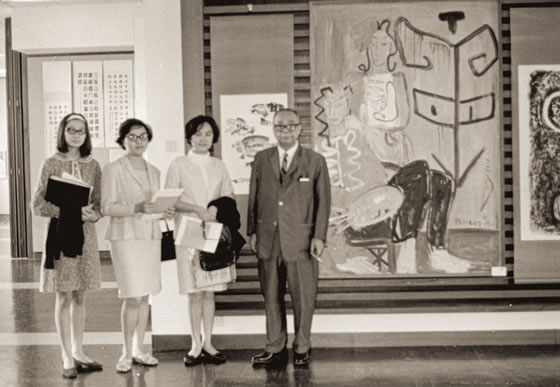
In February, Ting participated in the Modern Painting Masterpieces exhibition hosted by the Lion Rock Literary Gathering.
—
In June, Ting attended the graduation party of New Asia College Department of Fine Arts. When members of the faculty and students took a small yacht out in Clearwater Bay, sudden strong winds overturned it. Most of the passengers were saved, and Ting suffered a minor bruise to his forehead.
—
On 6 October, the evening of the August Moon Festival, Ting invited his student Mok E-den to his home to enjoy the moon and look at some paintings.
—
Also in October, Ting participated in a New Asia College faculty-and-student exhibition.
In December, Ting participated in a painting exhibition organized by the art association of Chung Chi College.
—
In this year, Ting collected an ancient seal carved with the characters niu jun. Fond of this seal, he used it frequently on his own paintings. Later he carved several seals with niu jun himself.
In March, Wu Yiqing held a solo ink-painting exhibition, for which Ting wrote an article.
—
In April, Ting wrote an essay for Lai Bing Chiu’s sixth faculty-and-student exhibition.
—
In June, Ting wrote the preface for Chan Pingkwong’s Shou Ru Tang Collection of Calligraphy, Paintings, and Seals.
—
In October, Ting participated in the Twentieth Anniversary Art Exhibition of New Asia College.
—
In the same month, at the invitation of the Hong Kong Chinese Art Club, Ting gave a lecture on the evolution and special characteristics of Chinese ink paintings and their influence on the world art scene.
—
Also in October, RTV (Rediffusion Television Limited, renamed Asia TV in 1982) interviewed Ting in a special series titled Famous Paintings and Painters. In April of the following year, he was invited to demonstrate Chinese painting on the show.
In November, He Tiehua made a brief stop in Hong Kong to meet with artists, including Ting, Chao Shao-an, and Lou Lo-pang, to discuss the possibility of establishing a Chinese art museum in New York.
—
From the end of November to the beginning of December, Ting participated in the Senior Painting and Crafts Exhibition at the May May Children’s Department Store to celebrate the International Day of the Elderly.
—
Ting presided over the opening ceremony of the fourth Executive Committee meeting of the Guangzhou Municipal Art School’s Hong Kong Alumni Association.
In March, Ting participated in the First Republic of China Painting Exhibition, organized by the National Museum of History in Taiwan and the Chinese Cultural Renaissance Council, showing Lotus and Mandarin Ducks.
—
From June to July, Ting visited the exhibition of Ming and Qing dynasty paintings, among which Luo Ping’s Ghost Diagram triggered his interest in the theme of ghosts to such an extent that he began to paint ghosts daily.
—
In August, Lai Bing Chiu hosted his seventh faculty-and-student exhibition at his Elsa Art House, for which Ting contributed a review.
—
In October, Ting participated in the Members’ Painting Exhibition of the Hong Kong Teachers’ Association.
From November to December, Ting held a solo exhibition at the University of Guelph Art Gallery in Ontario, Canada.
—
In December, Szeto Kei held a solo exhibition at Hong Kong’s City Museum and Art Gallery, for which Ting wrote “Szeto Kei Exhibition and the Spirit of Guangdong.”
In January, Ting attended an exhibition of Zhonghua University of Fine Arts alumni Gao Hanxiong’s paintings.
—
In February, Ting participated in the Village Paintings Exhibition, organized by the Village Painting Club.
—
At the beginning of March, Ting showed oil and ink paintings in a New Asia College faculty-and-student exhibition.
—
At the beginning of September, Ting gave a speech to celebrate Lin Jen Tung’s publication Bibliography of the Contemporary Chinese Painting Artists and his qualification for the Sixth National Art Exhibition.
—
In late September, Ting attended the opening ceremony of Shue Yan College.
In October, at the invitation of the Hong Kong Chinese PEN Conference, Ting gave a speech entitled “The Evolution of Chinese Ink Painting.”
—
In December, Ting lectured at New Asia College on painting and ancient script.
—
Ting presided over the opening ceremony of the fifth Executive Committee meeting of the Hong Kong Alumni Association of Guangzhou Municipal Art School’s Hong Kong Alumni Association.
Ting was appointed dean of the art department at Tsing Hua College, a post he held until 1977.
—
In June, Ting served as judge for Lai Bing Chiu’s ninth faculty-and-student exhibition, held at Hong Kong’s City Hall.
—
In October, Ting, together with other members of Hong Kong’s cultural circle, held an exhibition for the artist Li Fuhong.
In January, at the invitation of the Hong Kong Alumni Association of Guangzhou Municipal Art School, Ting spoke at the ceremony celebrating the tenth anniversary of the association’s founding, and he showed oil and ink paintings in an exhibition for the event.
—
Also in January, Mok E-den published Contemporary Chinese Painting by Ting Yin Yung.
—
In March, New Asia college held a solo exhibition for Ting at Hong Kong City Hall. According to reports, Ting was invited by the University of Paris VII to participate in the 29th International Congress of Orientalists and oriental art exhibition to be held at the Paris-Sorbonne University (University of Paris IV). The exhibition organized by New Asia college was a preview for the Sorbonne exhibition, and prominent academicians such as Tang Chun-i, Xu Fuguan and Chen Shih Wen wrote prefaces for the exhibition catalogue.
On 15 July, Ting traveled to Paris and a few days later went to Sorbonne to personally supervise the display of his exhibition. Chinese artists living in Paris, Zhu Teh Chun and Zao Wouki attended the exhibition. In addition to Paris, Ting also traveled to London, Rome, Florence and Pompeii, and returned to Hong Kong in mid-August. This was the only trip he ever made to Europe.
—
In June, the Pok Art Gallery organized an exhibition of Ting’s works.
—
In mid-July, Ting participated in an exhibition organized by Taiyilou Gallery of its collection of important masterpieces.
—
At the end of July, Ting served as a judge, along with Liu Kuo-sung, Siu Lap Sing, Liu Sihao, and Lai Yuk Hay, for the Art Creation Exhibition organized by the Student Union of the Chinese University of Hong Kong for the upcoming Chinese Cultural Festival.
In September, Ting started to teach ink painting in the Department of Extramural Studies of the Chinese University of Hong Kong, continuing until 1978.
—
Also in September, Ting attended the inauguration ceremony for the Hong Kong Chinese Calligraphy Association.
—
In October, the photographer and painter Cheng Guanjian (Cheng Ziran) held a solo exhibition that included a painting he had painted together with Ting. Ting wrote an essay for the exhibition.
—
In November, Ting participated in a faculty-and-student exhibition at New Asia College.
—
From November to December, Ting was interviewed for the Chinese Modern Artist Oral History research project established by the Chinese Culture Institute of the Chinese University of Hong Kong and hosted by Mayching Kao.
—
In December, Ting wrote a review for Szeto Kei’s Kapok and Peony Exhibition at City Hall.
In March, Kojiro Kono, head of the Japanese Southern Painting Institute, invited Ting, Siu Lap Sing, and Jao Tsung-I to participate in the Japanese Southern Painting Institute’s fourteenth exhibition. Ting showed the ink painting Lotus and Mandarin Ducks. From this year until his death, Ting participated each year in the institute’s exhibitions.
—
From March to April, Ting participated in Modern Chinese Painters in the Traditional Style, an exhibition held at the University Art Gallery of the University of Melbourne in Australia.
Ting became a member of the Hong Kong Poetry, Calligraphy, and Painting Association, founded in June.
—
In June, Ting, along with Liu Kuo-sung, Siu Lap Sing, Van I-Pong, Tseng K’o-tuan, and Sheung Chun-ho, participated in an exhibition of modern works by leading east Asian artists sponsored by Yale-in-China that was shown at Yale, the University of Pittsburgh, Pennsylvania State University, and Dartmouth College.
—
In September, Ting participated in New Asia College’s Twenty-fifth Anniversary Art Exhibition.
—
In October, at the invitation of Wah Har College, Ting gave a lecture on the spiritual cultivation of art. During his lecture, he demonstrated ink painting.
—
Ting published this year’s prices for his paintings, calligraphy, and seal engravings.
In January, Ting attended an exhibition of works by Szeto Kei’s students, for which he wrote an article.
—
In March, Ting wrote an article for his colleague at New Asia College, John Li, entitled “Preface to John Li’s Drawing and Print Exhibition.”
—
In July, Taipei’s Lion Art Monthly published a special issue on Ting.
—
In August, at the invitation of the Rotary Club of Kowloon West, Ting gave a speech entitled “The Chinese Nation and Culture.” He later gave an ink-painting demonstration, presenting the paintings to members of the audience.
—
East and West Art Gallery in Melbourne organized a solo exhibition for Ting. The National Gallery of Victoria, the University of Melbourne, and Monash University all purchased paintings by Ting during this exhibition.
—
T. C. Lai, dean of the Department of Extramural Studies of the Chinese University of Hong Kong, published Three Contemporary Chinese Painters: Chang Da-chien, Ting Yin-yung, Ch’eng Shih-fa.
In May, Tang Wai Hung published Selection of Seals by Ting Yin Yung.
—
In June, Nishida Ōdō published The Calligraphy, Painting, and Seals of Ting Yin Yung.
—
In July, Ting was interviewed by Li Luoxia; the interview was later published as “Ting Yin Yung Interview.”
—
Also in July, Ting started selling his paintings at the Figure-Four Gallery, a collaboration that would continue until Ting’s death.
—
In August, East and West Art Gallery held a second solo exhibition of Ting’s work. Ting traveled to Melbourne to attend the opening and to demonstrate ink painting for the members of the National Gallery of Victoria.
—
In November, the Hong Kong Arts Centre organized an exhibition at the Bank of America that included works by Ting, Ren Zhenhan, Luis Chan, Liang Boyu, Zhang Bihan, Young Sin Sum, Cheng Kar-Chun, and Liu Dabu.
In January, Taipei’s Lung Men Art Gallery and Artist Magazine organized the Ting Yin Yung Art Exhibition.
—
In February, Ting was invited to demonstrate chrysanthemum and lotus painting in the TV course Introduction to Chinese Painting, jointly organized by the Department of Extramural Studies of the Chinese University of Hong Kong and Commercial Television.
—
In March, Ting participated in a New Asia College faculty-and-student exhibition.
—
In May, Ting organized an exhibition of paintings and calligraphy by George K. C. Yeh at the Hong Kong City Hall.
—
In June, the Department of Fine Arts of the Chinese University of Hong Kong hosted a retrospective exhibition of paintings by Siu Lap Sing, for which Ting wrote “From Han and Wei Carvings to the Art of Siu Lap Sing.”
In July, Ting consigned 24 ink paintings to the Swindon Book Company in Tsim Sha Tsui.
—
In October, East and West Art organized Ting’s third solo exhibition in Melbourne.
—
Walasse Ting, who lived in New York, visited Hong Kong and went to Ting’s home accompanied by Fang Chao Ling.
—
Chow Fai and Terry Tong, graduates of the Department of Fine Arts of the Chinese University of Hong Kong, produced a documentary on Ting’s art, Old Man and His Paintings, that chronicles Ting’s life and art.
In January, Ting attended an exhibition of paintings by Professor Jao Tsung-I at the Chinese University of Hong Kong as an honored guest.
—
In May, Ting received an invitation from Chung Chen Sun, founder and dean of the Malaysian Institute of Art, to have exhibitions in Singapore and Kuala Lumpur later in the year.
—
In July, Ting retired from the Department of Fine Arts of the Chinese University of Hong Kong.
—
In September, Ting participated in the Chinese Ancient and Modern Flower Painting Exhibition jointly organized by Deng Shi Wen Yuan Guan and the International Gallery.
—
On 23 December, Ting passed away at St. Teresa’s Hospital in Kowloon.
